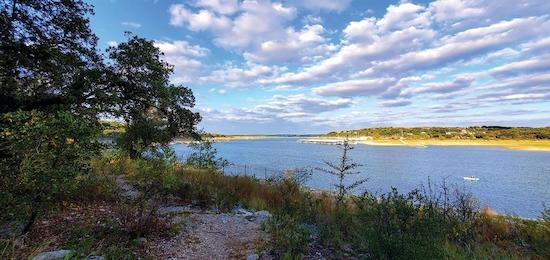
Hurst Creek is a tributary of the Colorado River that empties into Lake Travis.
Janaury 12, 2022 - New Year’s resolutions are often fleeting with reduced interest as time passes. The Texas Water Development Board (TWDB) is instead kicking off the New Year with a challenge to commit your involvement to ensuring the future of water in Texas.
And you can start by familiarizing yourself with the most significant water topics in Texas, including the strategies and projects outlined to meet Texas’ projected water supply needs through 2070.
The TWDB just released the graphically enhanced version of the 2022 State Water Plan, which was adopted by the Board in July 2021.
“The primary goal of the TWDB’s state water plan is to make sure that water users in the agricultural sectors, manufacturing, irrigation, livestock, and municipal users have the water that they need to meet their demands during drought conditions,” said TWDB Director of Water Supply Planning Temple McKinnon. “This is to provide for economic activity, public health and welfare, and protecting natural and water resources of the state."
The 2022 State Water Plan projects Texas’ population will increase 73 percent over the next 50 years, from 29.7 million in 2020 to 51.5 million in 2070. Along with that growth comes a projected 9 percent increase in total water demand. Texas’ existing water supplies—those that can already be relied on during drought—are projected to decline 18 percent during this time.
To meet potential water shortages during a drought of record, the plan contains 5,800 strategies, such as conservation and reuse, aquifer storage and recovery, brackish groundwater and seawater desalination, and surface water strategies. The estimated capital cost of implementing the 2022 plan is approximately $80 billion, and water providers anticipate needing $47 billion of that in state assistance.
The TWDB produces a new state water plan every five years based on plans developed by 16 regional water planning groups. The 2022 plan marks the fifth state water plan created under Texas’ widely recognized regional water planning process.
For the first time, there is a standalone chapter in the plan focused on conservation. The intent is to define the legislative requirements, highlight initiatives within the TWDB’s conservation division, and illustrate how planning groups use the information to develop their plans.
Other new additions to the 2022 State Water Plan and development process include improvements to projection methodologies, accelerated development of the socioeconomic impact analyses, a drought management costing tool to assist planning groups in their strategy evaluations and decision making, and realistic timelines for large projects.
The graphically enhanced 2022 State Water Plan is now available on the TWDB website along with the Interactive 2022 State Water Plan. This web application enables users to take an in-depth look at the 2022 State Water Plan data, projects, and strategies to see how water needs change over time, with filter options that allow viewing at different geographic levels—from statewide details down to the water user level.
“You can browse information from these plans down to the region or the county or the specific water user group. You can access every aspect of planning factors for these entities, from their supplies to their demands, and how they plan to meet their future needs. I definitely encourage folks to utilitize our website to find visual tools to explore the data behind the state water plan,” said McKinnon.
Interested in accepting the TWDB’s challenge to get more involved in Texas water this year? Planning efforts for the 2027 State Water Plan are already underway.
Regional water planning groups are holding public meetings to develop the 2026 Regional Water Plans. Additionally, public water systems across the state are currently working on their annual water use surveys, due by January 31, using new dashboards developed by the TWDB to help review their historical water use. This water use data is foundational to the development of the water demand projections used in the development of the regional and state water plans.
“We definitely encourage the public to get involved in the regional water planning group meetings. All of their meetings are posted open public meetings on our website. We have information on when planning groups are meeting and how the public can get in contact with the administrators of these planning groups,” said McKinnon.
The TWDB is the state agency charged with collecting and disseminating water-related data, assisting with regional water and flood planning, and preparing the state water and flood plans. The TWDB administers cost-effective financial assistance programs for the construction of water supply, wastewater treatment, flood control, and agricultural water conservation projects.









